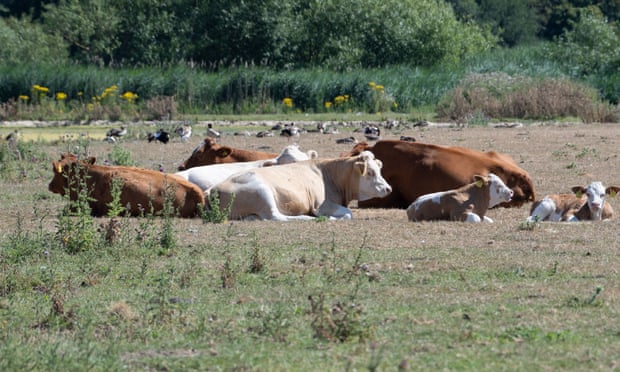
A growing number of UK farmers are considering adapting their farms to protect animals against heat stress, and among the new measures is the idea of indoor “siestas” for cows that may normally be grazing outdoors in summer.
Heat stress is a major issue for cattle, especially modern dairy cows, which can produce 10-15% less milk in hotter temperatures. It can also effect their fertility and increase the chances of early pregnancy losses.
“A cow in 25C heat feels like we would in 40C,” says Ed Bailey at George Farm Vets in Wiltshire. “They are very sensitive to heat because of the fermentation tank inside their bodies – it constantly produces a lot of heat.”
While sheep are shorn of their wool and beef cattle are not as metabolically active, dairy cows, particularly higher-yielding breeds, are less adapted to heat stress. Pigs and poultry are mostly housed indoors, although the UK does have a large outdoor pig herd.
Helen Browning, dairy farmer
There has been a drive to ensure that as much of the UK dairy herd as possible grazes outdoors in summer. But the industry is slowly waking up to the fact that being out on grass is not always a good thing, says Tom Chamberlain, a vet and farming consultant.
Chamberlain is working with farmers who are trialling the practice of bringing their cows indoors during the daytime. He says that cows start to suffer once the temperature goes above 20C.
The siesta was designed to give Spanish agricultural workers a break during the hottest part of the day. Similarly, cows are being let outside after morning milking before being brought back indoors into barns over lunchtime, and then let outside again in the evening after afternoon milking. “As long as it’s still light, they’ll eat [grass],” says Chamberlain.
Bailey says that buildings can offer a cooler environment for cows and can also be improved with proper ventilation, fans and sprinklers. Other options for protecting against heat stress include: once-a-day milking to reduce the stress of walking to and from the milking parlour; movable sheds to take out into fields to livestock in times of heat stress; and making the most of shade from trees.
“I wish we’d planted more trees on our farm,” says dairy farmer and chief executive of the Soil Association Helen Browning. “They bring benefits for wildlife and carbon but also shade and shelter – but they would take 20 years to grow now.”
Advertisement
She is now considering bringing cattle indoors during the daytime. “We’d milk early in the morning and keep them indoors for the heat of the day before turning them out to graze overnight, then inside again in the morning,” she says.

Pigs on a silvopasture farm in Denmark where trees have been grown to provide shade in summer. Photograph: hestbjerg.dk
https://www.theguardian.com/environment/2022/jun/22/india-dairy-farmers-face-searing-heat
Some pig farmers are already experimenting with planting trees to provide shade, as well as space to roam, for animals in summer. In Denmark, Marianne and Bertel Hestbjerg planted fast-growing poplar trees which, they say, took just five years to grow large enough for their pig herd to use.
“Before the trees, we had about three pigs that would die every year. Heat stress is a challenge, as pigs don’t sweat. The trees are especially useful for pigs when they are giving birth, as it’s a very stressful period for them,” says Marianne.
Beyond shade and cooling techniques, farmers could also consider moving calving to summer so that cows are less metabolically and physically active during the hottest months, says Bailey. Alternatively, less popular breeds such as Jersey cows are more resilient against heat stress, he says.





